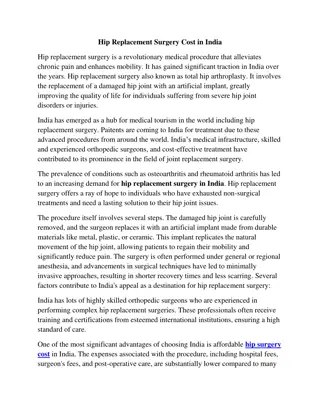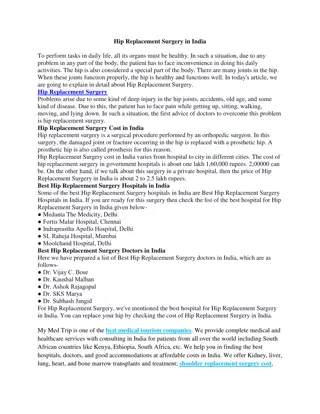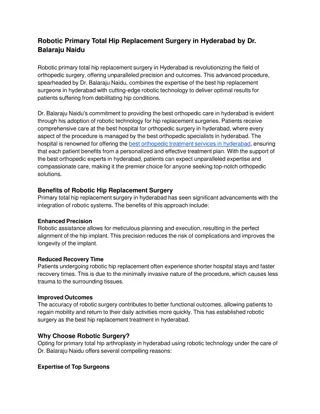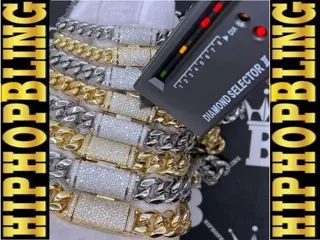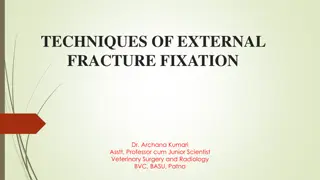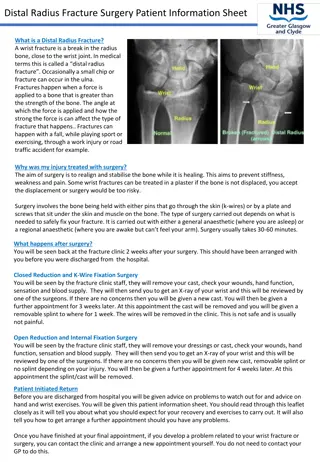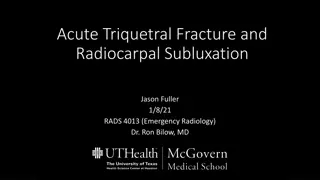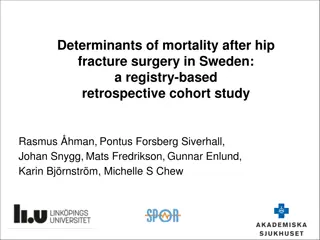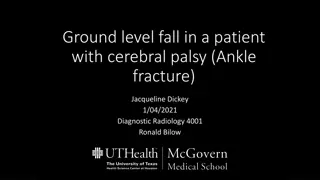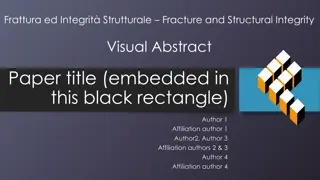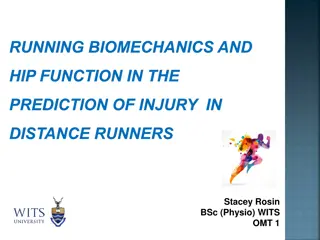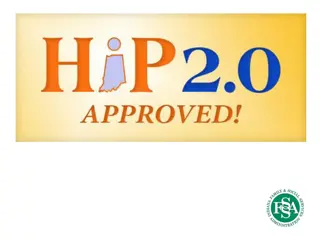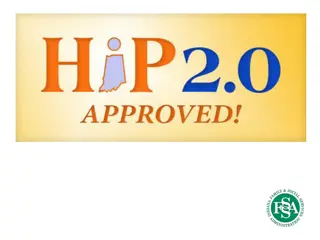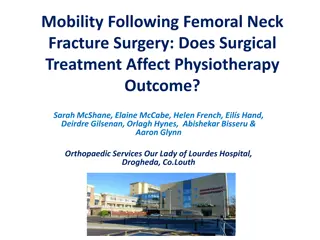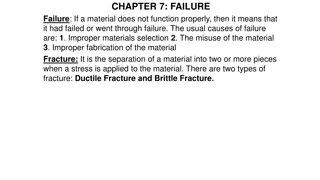Enhancing Hip Fracture Care and Outcomes: A Comprehensive Approach
Improving hip fracture care and outcomes requires raising standards, implementing effective strategies, and ensuring multidisciplinary management. The Hip Fracture Programme Model outlines key elements including assessment, rehabilitation, and coordination across healthcare services. Through strategic interventions and governance responsibility at all care stages, an enhanced model demonstrates improved effectiveness and cost-efficiency compared to usual care practices.
Download Presentation

Please find below an Image/Link to download the presentation.
The content on the website is provided AS IS for your information and personal use only. It may not be sold, licensed, or shared on other websites without obtaining consent from the author. Download presentation by click this link. If you encounter any issues during the download, it is possible that the publisher has removed the file from their server.
E N D
Presentation Transcript
IMPROVING HIP FRACTURE CARE AND OUTCOMES Cameron Swift. King s College School of Medicine, London July 2023
Background need & opportunity Epidemiological and public health importance Recognised need to raise standards Professional & political momentum Demographic paradigm for health care Contemporary national Clinical Guidance (e,g. CG124 & QS16) National audit (NHFD) and Best Practice Tariff
CG124 (2011 -14 -17-19) Categories 1. Imaging options in occult hip fracture 2. Timing of surgery 3. Analgesia 4. Anaesthesia 5. Planning the theatre team 6. Surgical procedures (2017 / 2019/ 2023 updates) 7. Mobilisation strategies 8. Multidisciplinary management (HFP) 9. Patient and carer information
Hip Fracture Programme Model [CG124] Acute orthopaedic or orthogeriatric ward base Orthogeriatric assessment Rapid optimisation of fitness for surgery Early identification of individual goals for multidisciplinary rehabilitation to recover mobility and independence, and to facilitate return to pre-fracture residence and long-term wellbeing Continued, coordinated, orthogeriatric and multidisciplinary review Liaison or integration with related services, particularly mental health, falls prevention, bone health, primary care and social services Clinical and service governance responsibility for all stages of the pathway of care and rehabilitation, including those delivered in the community.
Management of hip fracture Accident & Emergency: Preliminary Assessment - Surgical, Anaesthetic, Medical, Nursing, Rehab goals Theatre Orthopaedic / Specialist Ward: Perioperative surgical, nursing and related management with referral as required Usual Care MDM: HFP MDR: SD MDR: GORU MDR: IC MDR: MARU MDR: SC FINAL DISCHARGE
Key model inputs and CEA findings COSTS FOR EACH STRATEGY: Rehab programme Complications Readmissions Health care costs after hospital discharge Social care costs (when living in own home or in residential or nursing home) HEALTH OUTCOMES FOR EACH STRATEGY EQ-5Ds scores for all health states* Life expectancy HEALTH STATES = QALYs HFP is the DOMINANT STRATEGY (more effective, less costly) than both GORU/MARU and usual care
NICE Quality Standards Not fixed targets Measurable high level audit measures of local quality in structure, process or outcome Expressed as proportions not necessarily 100% norm Maximally evidence-based Where possible, set in the context of national data collection for Hip # the NHFD Selection periodically adjusted for perceived priority improvement need.
QS16 Statements (1-3) 1. Adults with hip fracture are cared for within a Hip Fracture Programme at every stage of the care pathway. [2012, updated 2016] 2. Adults with hip fracture receive surgery on a planned trauma list on the day of, or the day after, admission. [2012, updated 2016] 3. Adults with displaced intracapsular hip fracture have a total hip replacement if clinically eligible, rather than hemiarthroplasty. [2012, updated 2017]
QS16 Statements (3-6) 4. Adults with trochanteric fractures above and including the lesser trochanter receive extramedullary implants. [2012, updated 2016] 5. Adults with subtrochanteric fracture are treated with an intramedullary nail. [new 2016] 6. Adults with hip fracture start rehabilitation at least once a day, no later than the day after surgery. [2012, updated 2016]
NHFD Evidence-based KPIs 2019 & 2021 (COVID19) RCP NHFD 2022 2019 2021
NHFD Evidence-based KPIs to end January 2023. RCP NHFD 2022
KPI 6: Discharge destination (120-day follow-up in only 40% esp units) (NHFD 2020)
Seasonal variation in 30-day hip# mortality, 2011-2018 (NHFD 2019) (See also Griffin et al 2021: EQ-5D-5L)
KPI 3: CG124-Consistent Surgical Procedure (to 2017) IM nail for subtrochanteric fracture SHS (v IM nail) for A1 / A2 trochanteric fracture Cemented arthroplasty (hemi/THA) for displaced intracapsular fracture THA if (i) outdoor mobile (+/- stick), (ii) cognitively intact & (iii) medically GA fit.
THR Dec 2018 Feb 2021 (NHFD 2021)(see HEALTH nejm 2019: Judge et al bjj 2020)
Variability in THR (NHFD 2019) (see HEALTH nejm 2019: Judge et al bjj 2020)
Rates of THA and hemiarthroplasty set against criteria that define greatest fitness (NHFD 2021)
Surgical procedure NICE CG124 Jan 2023 Consider total hip replacement rather than hemiarthroplasty for people with a displaced intracapsular hip fracture who: were able to walk independently out of doors with no more than the use of a stick and do not have a condition or comorbidity that makes the procedure unsuitable for them and are expected to be able to carry out activities of daily living independently beyond 2 years. [2023]
Surgical Procedure NICE CG124 (Revised) Jan 2023 Hospitals should aim to use a single type of cemented femoral component for hemiarthroplasties as standard treatment for displaced intracapsular hip fracture management. [2023] If equivalent cemented femoral component designs are available, organisations should take into account overall costs, including training needs, and how familiar the team is with the component. [2023] Record long-term data on hemiarthroplasties, including patient- reported outcomes and adverse events, for submission to a national registry. [2023] Use extramedullary implants such as a sliding hip screw in preference to an intramedullary nail in people with trochanteric fractures above and including the lesser trochanter (except reverse oblique). [2011 Rev 2023]
NHFD Additional developments (NHFD 2021-22) Transition from annual audit report to quarterly online QI platform New additional KPI s KPI 0: (i) prompt nerve block consideration & (ii) prompt admission to appropriate ward. KPI 7: Medication for secondary prevention with 120-day follow-up Data on periprosthetic and non-hip femoral fractures Integration of NAIF & inpatient hip#
IHF LOCATION (NAIF 2019) (RCP 2020)
NHFD 6 KPIs FOR INPATIENT & NON-INPATIENT HIP FRACTURE [NHFD 2022]
EVIDENCE - POSITIVE: Effect of targeted risk factor reduction programme on inpatient falls (per thousand occupied bed days)(Healey et al, 2004) 25 20 15 Pre Post 10 5 0 Control Intervention
Fallsafe care bundle key elements [RCP 2015] Bed-rail/Ultra- low bed strategy* Cognitive assessment* Delirium screen* Lying & standing blood pressure & pulse* Medical & medication review* Basic visual check* Tailored on- ward (v 2-hr) observation regimen
INPATIENT IMPLEMENTATION & OUTCOME MEASUREMENT Fallsafe QI evaluation [Healey et al 2014]
EVIDENCE: NICE CG 161: COST-EFFECTIVENESS OF INPATIENT FALLS PREVENTION
NATIONAL AUDIT SNAPSHOT KPI DATA - INPATIENT FALLS PREVENTION 2017 (v 2015) (RCP NAIF 2019)
NATIONAL AUDIT & QI: Inpatient falls per 1,000 bed days AT Northumbria Healthcare NHS Foundation Trust 2013 2020. (Richardson et al., 2020)
2021 NAIF KPIS (85% Trusts) (NAIF 2022)
2021 (85% Trusts) post-fall management (v 2018 - 45%/ 20%/ 54%) (NAIF 2022)
Outcome effects of some organisational factors (REDUCE Study: Patel et al 2022) Superspell LOS; +/- 2 day reduction with (e.g.) Prompt O-G assessment Prompt mobilisation 30-day casemix adjusted mortality; 10% reduction with (e.g.) Patient experience feedback discussion at clinical governance meeting Prompt surgery to >80% of patients
Some NHFD-based recommendations for local progress & QI: [NHFD 2022] Quarterly and monthly multi-d governance meetings to review performance and plan QI Use NHFD runcharts and KPI caterpillar plots to (i) monitor QI progress and (ii) best practice alongside better performing units Use new KPI s 0 & 7 to improve respectively (i) nerve block use and fast track admission to appropriate ward; (ii) bone health follow-up and secondary # prevention

 undefined
undefined








